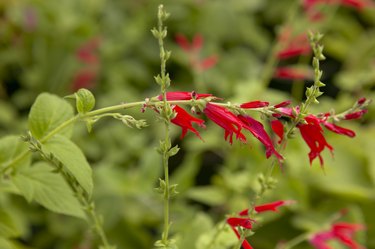
Salvia elegans, or pineapple sage as it is known because of the pineapple-like scent of its leaves, is a plant from the mint family. This fragrant plant has multiple uses, making it a great addition to your herb garden. Here are some of the things you can do with pineapple sage.
Read more: What Are the Benefits of Eating Whole Mint Leaves?
Video of the Day
Video of the Day
Attract Hummingbirds and Butterflies
The University of Arkansas explains that Salvia elegans is largely a frost-tender perennial that is native to Mexico and Guatemala, where it would grow at the edges of the pine forests as a semi-woody shrub. Florida A&M University clarifies that pineapple sage is not related to the pineapple plant in any way.
In gardens, pineapple sage usually grows to about 3 to 4 feet tall and has a wide, rounded form. Salvia elegans has short leaves that are either green or golden, with bright red, long, spiky flowers that give it a Christmassy look.
Pineapple sage attracts hummingbirds and butterflies, according to Texas A&M University, so if you do plant it in your garden, you can expect to see these visitors dropping by. Pineapple sage blooms from late summer to early fall (around August to October), and it's a hummingbird favorite because other sources of food are scarce around that time.
Cook With Pineapple Sage
The University of Arkansas notes that the leaves and flowers of the pineapple sage plant are edible and very aromatic, making them a great garnish for foods and a flavoring agent and decorative element for baked dishes. For instance, you can sprinkle them on top of salads, drinks like iced tea and fruit juices, and desserts like ice cream and cheesecake.
Read more: 8 Cocktail Recipes Fresh From the Garden
You can even chop up the leaves and flowers and use them in your cooking. According to Florida A&M University, they have a rich flavor that goes well with several types of dishes, including breads, sandwiches, smoothies, salsa, fritters and chicken dishes. They taste especially great blended into banana smoothies, kneaded into raisin bread and mixed with cream cheese to make a fruity spread.
Pineapple sage can also be used to brew tea; the University of Wisconsin-Madison says you can steep either fresh or dried pineapple sage flowers or leaves in hot water to brew a comforting herbal tea. The tea can be served either hot or cold, whichever you prefer. Per Florida A&M University, you can also use pineapple sage to make jellies by steeping it in hot apple juice and then using the juice to make jelly.
If you're trimming leaves from the plant to cook with, the University of Wisconsin-Madison recommends snipping off young, tender leaves in the mornings. Florida A&M University says you can use the leaves immediately or you can dry them and use them later; however, drying them can dim their fragrance.
You'll be pleasantly surprised to learn that eating pineapple sage is also good for your health. An August 2017 study published in the journal Food & Nutrition Research states that pineapple sage flowers get their red color from plant compounds known as anthocyanins. Anthocyanins have antioxidative and antimicrobial properties that help boost neural and visual health and protect you against several diseases.
Another study, published in the December 2018 issue of the journal Molecules, notes that pineapple sage has been widely used in traditional medicine, to lower blood pressure and to treat insomnia, anxiety and nervous system disorders.
Read more: What Are the Health Benefits of Sage Tea?
- University of Arkansas: “Plant of the Week: Salvia elegans, Pineapple Sage”
- Texas A&M University: “Herbs for Texas Landscapes”
- Florida A&M University: “SDA Newsletter”
- North Carolina State University: “Salvia elegans”
- University of Wisconsin-Madison: “Pineapple Sage, Salvia elegans”
- Food & Nutrition Research: “Anthocyanidins and Anthocyanins: Colored Pigments as Food, Pharmaceutical Ingredients and the Potential Health Benefits”
- Molecules: “Salvia elegans, Salvia greggii and Salvia officinalis Decoctions: Antioxidant Activities and Inhibition of Carbohydrate and Lipid Metabolic Enzymes”